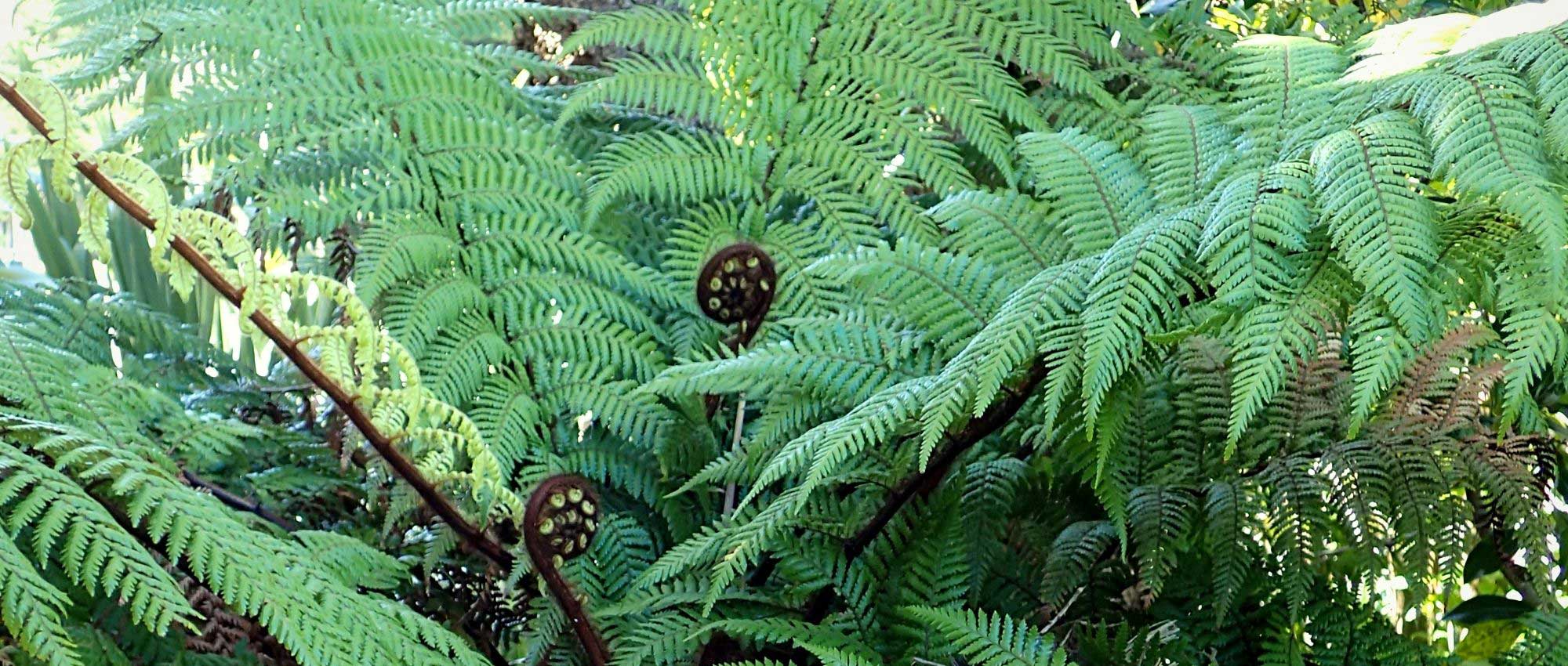
Dicksonia: planting, cultivation, and care
Contents
Dicksonia in a nutshell
- Dicksonia is a stunning tree fern with a very exotic style!
- It forms a brown stipe and displays large, finely divided fronds.
- Its lushness is appreciated, bringing a jungle vibe to the garden!
- It resembles a palm tree, but with much finer foliage!
- It requires a cool, shaded location and a humid atmosphere.
A word from our expert
Dicksonia are majestic arborescent ferns, with a very exotic style, and their silhouette resembles that of palms. They form a brown fibrous stipe and display at the top a crown of very large, finely divided fronds. However, they are plants that grow very slowly. The most well-known and hardy is the Dicksonia antarctica! But there are also other species, such as Dicksonia fibrosa and Dicksonia squarrosa.
The Dicksonia antarctica has changed its scientific name and is now called Balantium antarcticum. However, this name is much less known and less commonly used, so for the sake of clarity and simplicity, we will use its name Dicksonia in this article.
Cultivating Dicksonia is a bit tricky, but it is worth trying! It is particularly suited to rainy regions and mild winter temperatures (Brittany, Normandy, Basque Country…). It requires a shaded location and a humid atmosphere, and the stipe needs to remain relatively cool. Dicksonia easily becomes the centrepiece in a patio or an exotic scene in partial shade. Its lush foliage instantly gives the garden a jungle-like feel! It is ideal for accompanying palms, Cycas, hostas, Colocasias, Fatsias, Hedychiums…
Discover in this guide all our tips for successful cultivation: which variety to choose, where and how to plant it, how to care for it, and which plants to pair it with to create a beautiful atmosphere in the garden!
Botany
Botanical data
- Latin name Dicksonia sp.
- Family Dicksoniaceae
- Common name Dicksonia, Tree fern
- Flowering none
- Height usually no more than 2-3 metres in cultivation
- Sun exposure partial shade or shade
- Soil type cool, rich in humus
- Hardiness between -5 and -10 °C
Dicksonias are splendid tree ferns primarily native to mainland Australia, Tasmania, and New Zealand. Some also come from South America, New Caledonia, Indonesia, and the Philippines. There are 9 species, but the most well-known is Dicksonia antarctica, native to Australia. These tree ferns are found in the understory of rainforests, in moist valleys and ravines. In the wild, epiphytic plants, such as other ferns or mosses, are often seen growing directly on the stipe of Dicksonia.
Like other ferns, Dicksonias belong to the group of Pteridophyta. They are very ancient plants that appeared long before the dinosaurs. They are unique in being dependent on water for reproduction and have neither flowers nor fruits, simply because they emerged before plants invented flowers! Dicksonia are among the oldest ferns still in existence today, dating back around 350 million years and seeming to have evolved little since the Jurassic period.
Dicksonia belongs to the family Dicksoniaceae, named in honour of the Scottish botanist James Dickson (1738 – 1822). However, the species Dicksonia antarctica has recently been renamed and is now called Balantium antarcticum.
Many Dicksonia have been harvested from their natural habitat to enhance ornamental gardens. However, they are now protected in Australia and New Zealand, and their commercialisation is regulated.
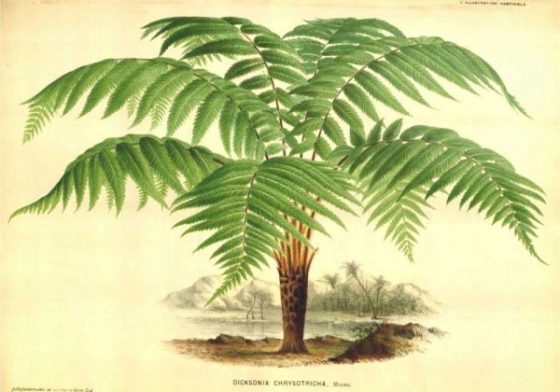
Dicksonia chrysotricha: botanical illustration
Dicksonia antarctica and D. fibrosa can withstand short periods of frost down to -7 °C. However, with winter protection, they seem capable of tolerating down to -10 °C. Dicksonia squarrosa, on the other hand, is somewhat less hardy.
Dicksonia does not form a true trunk, but a stipe made up of an upright rhizome covered by the stacking of the bases of old petioles and aerial roots. These allow the fern to capture atmospheric moisture. The stipe is also covered with numerous brown or rufous hairs. It measures between 20 and 60 cm in diameter and can take a straight, curved, or incurved shape. It is generally solitary but can also branch or produce offsets. D. squarrosa tends to branch more often than other species and can regrow from the base if the main stipe dies.
The stipe of Dicksonia is simply made up of remnants of previous growth (old petioles, old roots…). This forms a medium in which the fern’s roots can develop.
The silhouette of Dicksonia makes them resemble palms, but their foliage is much finer, more graceful, and airy. In its native habitat, Dicksonia antarctica reaches heights of between 5 and 15 metres. However, in cultivation under our climates, it rarely exceeds 2 or 3 metres in height. It can reach between 2 and 4 metres in spread, depending on the age of the plant and the size of the fronds.
Tree ferns grow very slowly (3 to 5 cm per year): thus, it takes years for them to develop a true stipe. This explains their high price.

A crozier of Dicksonia squarrosa, about to unfurl into a frond, the foliage of Dicksonia antarctica, and the stipe of D. squarrosa (photos Krzysztof Ziarnek)
As with other ferns, the fronds are initially coiled in a crozier when they appear in spring, then gradually unfurl. They are light green when young and become darker over time. They are grouped in a crown at the top of the stipe. Over time, the lower fronds eventually fall off, and new ones appear at the top of the stipe, allowing it to rise. The fronds have a very light and graceful appearance, as they are finely divided. They are borne on petioles covered in brown hairs. The fronds of Dicksonia resemble those of terrestrial ferns, such as the lady fern, but they are much larger! Those of Dicksonia antarctica measure between 1 and 3 metres in length.
The foliage of Dicksonia is evergreen. However, in a cold climate, Dicksonia may lose its fronds in winter, but they will reappear in early spring.
Like other ferns, Dicksonia does not produce flowers or seeds but reproduces by spores, which it produces in summer (it must be at least 15 years old to produce fertile fronds that bear these spores!). These are very fine particles that resemble dust. The spores are gathered in small sacs (sporangia) and are grouped in small clusters called sori. In Dicksonia, these sori are round and covered by indusia, small membranes that protect them. They are located on the underside of the fertile fronds, near the margin of the pinnules.
When mature, the sporangia open to release the spores, which are dispersed by the wind. Once on the ground, they will germinate in the presence of water and give rise to intermediate organisms, the prothalli, which resemble moss and bear the sexual organs. After fertilisation, new small fern plants will appear on these prothalli.
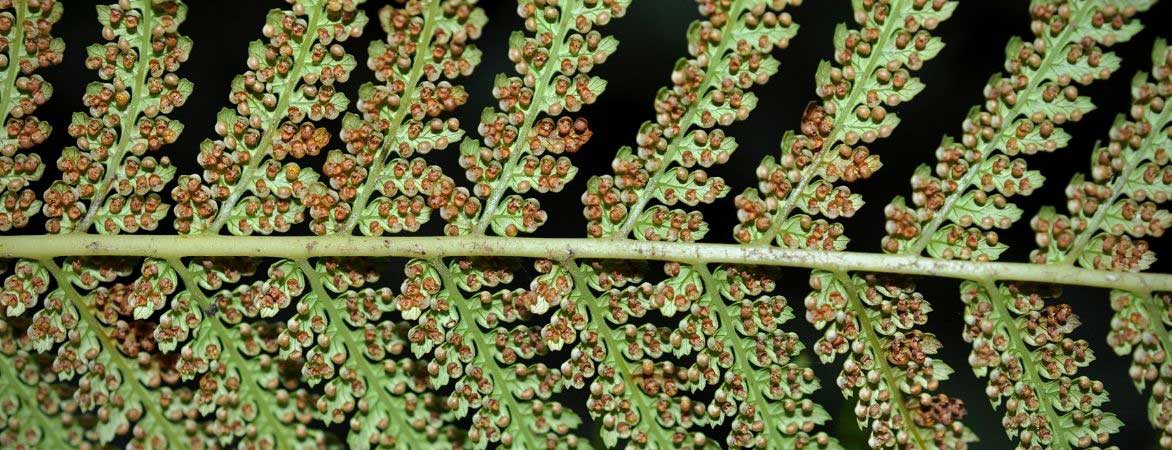
The spores of Dicksonia are grouped on the underside of the fertile fronds. Here, Dicksonia antarctica (photo Jean-Michel Moullec)
Read also
Ferns: growing and plantingThe main varieties of Dicksonia
The Most Popular Varieties
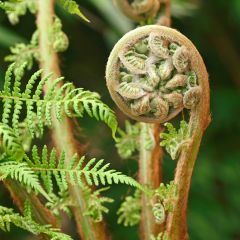
Dicksonia antarctica - Tree Fern
- Altura en la madurez 6 m
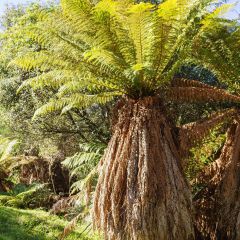
Dicksonia fibrosa - New Zealand Tree Fern
- Altura en la madurez 3 m
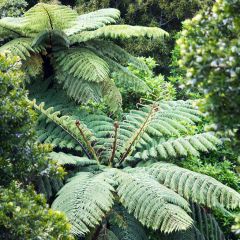
Dicksonia squarrosa - Tree Fern
- Altura en la madurez 3 m
If you are new to growing tree ferns, we recommend choosing D. antarctica, or possibly D. fibrosa, as D. squarrosa is a bit more delicate to cultivate.
Planting
Where to plant?
Dicksonia thrives in humid regions with regular rainfall and mild winters. It particularly enjoys Brittany, Normandy, and the Basque Country. Dicksonia is not a very hardy plant: you can plant it in the ground if you live in a region with a very mild climate, for example, near the Atlantic coast, around the Mediterranean, or if you benefit from a favourable microclimate. In colder regions, it is better to plant it in a large pot and shelter it for the winter. It is not suited to the hot, dry atmosphere of homes: to grow it indoors, it is best to place it in a greenhouse or conservatory, preferably with a misting system.
Dicksonia prefers semi-shaded or shaded locations and requires a humid atmosphere. Plant it in a protected spot, sheltered from wind and scorching sun. It enjoys cool, well-draining soils rich in organic matter, preferably acidic or neutral. It thrives under the same conditions as more common terrestrial ferns but especially needs a cool atmosphere to prevent the fronds and stipe from drying out.
Dicksonia antarctica can withstand short episodes of frost down to -7 °C, or even -10 °C with winter protection.
When to plant?
The best time to plant tree ferns is in spring, after the last frosts.
How to plant?
In the ground:
- Start by placing the pot in a basin filled with water to rehydrate the root ball.
- Dig a planting hole about three times the size of the root ball.
- Add well-decomposed compost to enrich the soil.
- Gently remove the fern from its pot.
- Position it in the planting hole, ensuring the stipe is upright.
- Fill the hole around the root ball with soil, then lightly firm it down.
- Water generously.
For more information, feel free to consult our advice sheet on planting tree ferns!
In a pot:
- Prepare a large pot with a rich, light substrate, such as a mix of leaf compost and garden soil, supplemented with some bark, sand, and heather soil.
- Place the Dicksonia in the pot, right in the centre, ensuring the stipe is upright.
- Add substrate all around and lightly firm it down.
- Water.
- Place the fern in semi-shade, in a spot sheltered from wind and cold.
- Feel free to install an automatic watering system.
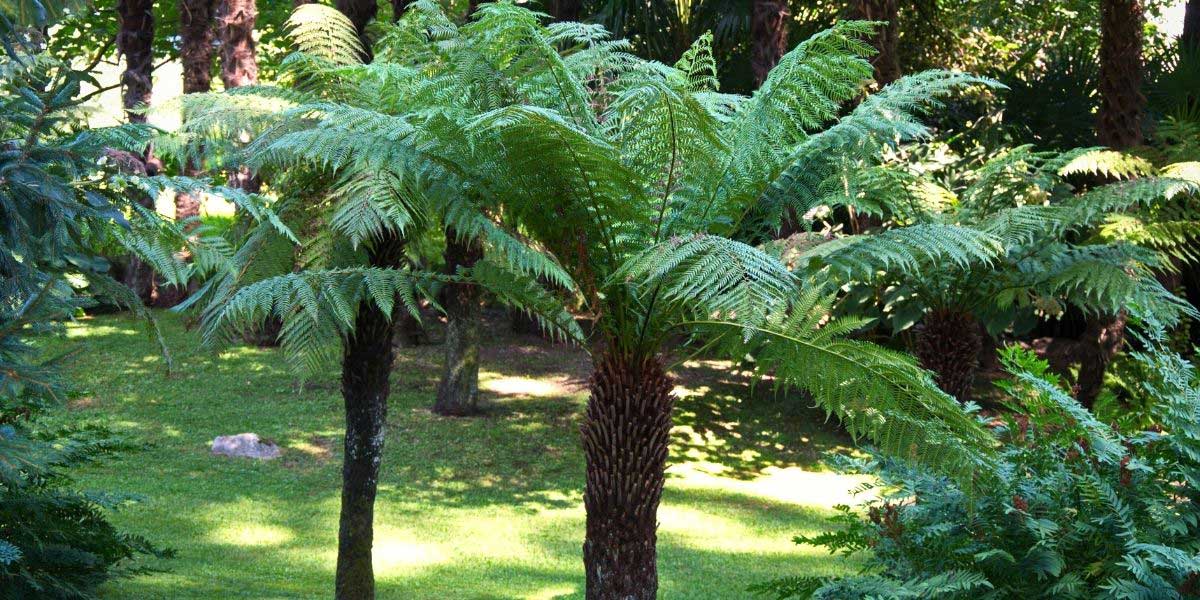
Dicksonia antarctica (photo Stefano)
Read also
How to sow fern spores?Entretien
Dicksonia needs its stipe to remain consistently moist. For watering, we recommend pouring rainwater directly onto the top of the stipe, at the centre of the crown of fronds. It will trickle down the stipe and keep it moist. Also water the substrate at the base of the fern, ensuring that it does not become waterlogged (risk of root asphyxiation). Preferably use rainwater rather than tap water. You can also install an automatic watering system by attaching drippers to the top of the stipe. If you are growing it in a greenhouse or conservatory, where the air tends to be dry, feel free to set up a misting system to prevent the stipe and the heart of the crown of fronds from drying out. This technique is also useful outdoors if the atmosphere is dry.
In spring and summer, if you are growing it in a pot, you can apply a little liquid fertiliser once or twice a month to promote its growth. Stop fertilising and reduce watering in autumn and winter.
It is important to protect Dicksonia from the cold in winter: if you are growing it in a pot, you can bring it indoors to a conservatory or unheated greenhouse. If it is planted in the ground, cut the fronds at the base before the first frosts, then place straw or dead leaves on top of the stipe (at the centre of the crown of fronds) and around it, and wrap it all with fleece. You can also keep the fronds and tie them together around the heart of the fern to protect the top of the stipe. We also recommend placing a good layer of fern fronds or mulch on the ground around the stipe.
If you are growing Dicksonia in a pot, we advise repotting it every year or every two years during the first few years (as Dicksonia get older, repotting can be spaced out more). Choose a pot that is slightly larger than the previous one each time.
Like other ferns, Dicksonia is not susceptible to diseases and pests.
If you cut the stipe of a Dicksonia, the base will not regrow, but the upper part has a chance of resuming growth. This can allow for the plant to be moved if it is difficult to uproot cleanly.
Multiplication
Sowing Spores
It is possible to propagate Dicksonia by collecting and sowing the spores. However, this is a plant that grows very slowly, and you will need to wait for years before seeing it form a true stipe.
If you do not sow them immediately, store the spores in the refrigerator.
The spores are tiny, resembling fine dust, and should be handled with care.
- Prepare a tray with a mixture of sieved potting soil and sand.
- Water to moisten it.
- Place the tray in the microwave for about 10 minutes to sterilise the substrate. This will prevent the growth of mosses or fungi.
- Wait for the substrate to cool, then gently scatter the spores on the surface. Do not cover them with soil!
- Cover with plastic wrap or a transparent glass lid to maintain a sterile and moisture-saturated environment.
- Place the tray in a bright location, out of direct sunlight, at a temperature between 16 and 20 °C.
- If you later notice that the substrate is drying out, you can water it occasionally by misting. Water is essential for fertilisation and the emergence of new ferns.
- As soon as the Dicksonia seedlings are large enough to handle, repot them into individual pots.
Division of Clumps
Dicksonia squarrosa sometimes produces offsets at the base of the stipe. If you are lucky enough to have some, you can cut them and replant them. This technique is simpler and quicker for propagating Dicksonia than sowing spores!
Association
You can easily create an exotic atmosphere, a jungle-like garden, by combining Dicksonia with other plants featuring lush foliage! Consider, for example, Gunneras, Fatsia japonica, Datisca cannabina, Tetrapanax, and giant hostas, such as the variety ‘Empress Wu’, which can reach up to 1.30 m in all directions. These plants will easily create a lush setting. You can also incorporate some climbing plants, like Akebia quinata. Its beautifully cut foliage features five ovate leaflets. Don’t forget about grasses, such as Hakonechloa macra, and bamboos, for example, Phyllostachys nigra. And let’s not overlook Hedychiums, which, in addition to their generous foliage, offer a very exotic flowering at the end of summer, bringing colour! You can pair them with Crinum powellii and Cannas.
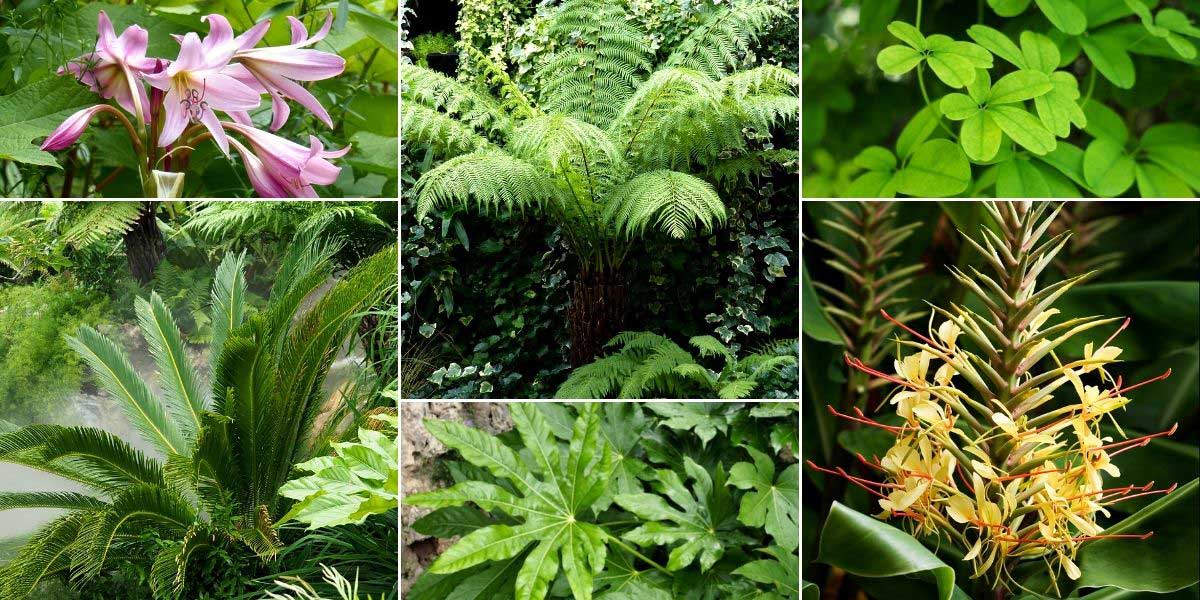
Dicksonia is ideal for creating a jungle-like garden, alongside other plants with lush foliage! Crinum powellii, Dicksonia antarctica, Akebia quinata, Cycas, Fatsia japonica, and Hedychium gardnerianum (photo JJ Harrison)
Tree ferns like Dicksonias are perfect for accompanying Cycas revoluta! This will give your garden a slight Jurassic feel! You can also include other tree ferns, such as Cyathea cooperi. However, be cautious, as it is a bit more frost-sensitive than Dicksonia and does not tolerate temperatures below -5 °C. It’s best to grow it in a pot and bring it indoors for the winter to protect it from the cold. To accompany these ferns and cycads, you might also choose a palm suitable for shade and cool soils, such as Rhapidophyllum hystrix. Exotic effect guaranteed!
Useful resources
- Discover Olivier’s video on Dicksonia antarctica
- To learn everything about ferns and their cultivation, check out our sheet “Ferns: Planting and Growing”
- Feel free to consult our sheet “Planting Tree Ferns”
- If you enjoy Dicksonias, also discover Cyatheas and our complete sheet on Cyatheas!
- For further reading, check out the book Hardy Ferns for the Garden by Cédric Basset and Olivier Ezavin, published in 2013 by ULMER
- Subscribe!
- Contents































Comments